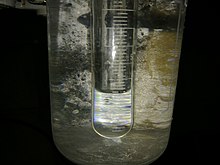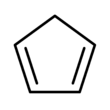Cyclopentadiene
| |||

| |||
| Names | |||
|---|---|---|---|
| Preferred IUPAC name
Cyclopenta-1,3-diene | |||
| Other names | |||
| Identifiers | |||
3D model (JSmol)
|
|||
| Abbreviations | CPD, HCp | ||
| 471171 | |||
| ChEBI | |||
| ChemSpider | |||
| ECHA InfoCard | 100.008.033 | ||
| EC Number |
| ||
| 1311 | |||
| MeSH | 1,3-cyclopentadiene | ||
PubChemCID
|
|||
| RTECS number |
| ||
| UNII | |||
CompTox Dashboard(EPA)
|
|||
| |||
| |||
| Properties | |||
| C5H6 | |||
| Molar mass | 66.103g·mol−1 | ||
| Appearance | Colourless liquid | ||
| Odor | irritating,terpene-like[1] | ||
| Density | 0.802 g/cm3 | ||
| Melting point | −90 °C; −130 °F; 183 K | ||
| Boiling point | 39 to 43 °C; 102 to 109 °F; 312 to 316 K | ||
| insoluble[1] | |||
| Vapor pressure | 400 mmHg (53 kPa)[1] | ||
| Acidity(pKa) | 16 | ||
| Conjugate base | Cyclopentadienyl anion | ||
| −44.5×10−6cm3/mol | |||
Refractive index(nD)
|
1.44 (at 20 °C)[3] | ||
| Structure | |||
| Planar[4] | |||
| 0.419D[3] | |||
| Thermochemistry | |||
| 115.3 J/(mol·K) | |||
Std molar
entropy(S⦵298) |
182.7 J/(mol·K) | ||
Std enthalpy of
formation(ΔfH⦵298) |
105.9 kJ/mol[3] | ||
| Hazards | |||
| NFPA 704(fire diamond) | |||
| Flash point | 25 °C (77 °F; 298 K) | ||
| 640 °C (1,184 °F; 913 K) | |||
| Lethal doseor concentration (LD, LC): | |||
LC50(median concentration)
|
14,182 ppm (rat, 2h) 5091 ppm (mouse, 2 h)[5] | ||
| NIOSH(US health exposure limits): | |||
PEL(Permissible)
|
TWA 75 ppm (200 mg/m3)[1] | ||
REL(Recommended)
|
TWA 75 ppm (200 mg/m3)[1] | ||
IDLH(Immediate danger)
|
750 ppm[1] | ||
| Related compounds | |||
Relatedhydrocarbons
|
Benzene Cyclobutadiene Cyclopentene | ||
Related compounds
|
Dicyclopentadiene | ||
Except where otherwise noted, data are given for materials in theirstandard state(at 25 °C [77 °F], 100 kPa).
| |||
Cyclopentadieneis anorganic compoundwith theformulaC5H6.[6]It is often abbreviatedCpHbecause thecyclopentadienyl anionis abbreviated Cp−.
This colorless liquid has a strong andunpleasant odor.At room temperature, this cyclicdienedimerizesover the course of hours to givedicyclopentadienevia aDiels–Alder reaction.This dimer can berestoredby heating to give the monomer.
The compound is mainly used for the production ofcyclopenteneand its derivatives. It is popularly used as a precursor to thecyclopentadienyl anion(Cp−), an importantligandincyclopentadienyl complexesinorganometallic chemistry.[7]
Production and reactions
[edit]
Cyclopentadiene production is usually not distinguished fromdicyclopentadienesince they interconvert. They are obtained from coal tar (about 10–20 g/t) and by steamcrackingofnaphtha(about 14 kg/t).[8]To obtain cyclopentadiene monomer, commercial dicyclopentadiene is cracked by heating to around 180 °C. The monomer is collected by distillation and used soon thereafter.[9]It advisable to use some form offractionating columnwhen doing this, to remove refluxing uncracked dimer.
Sigmatropic rearrangement
[edit]The hydrogen atoms in cyclopentadiene undergo rapid[1,5]-sigmatropic shifts.The hydride shift is, however, sufficiently slow at 0 °C to allow alkylated derivatives to be manipulated selectively.[10]

Even morefluxionalare the derivatives C5H5E(CH3)3(E =Si,Ge,Sn), wherein the heavier element migrates from carbon to carbon with a low activation barrier.
Diels–Alder reactions
[edit]Cyclopentadiene is a highly reactivedienein theDiels–Alder reactionbecause minimal distortion of the diene is required to achieve the envelope geometry of the transition state compared to other dienes.[11]Famously, cyclopentadiene dimerizes. The conversion occurs in hours at room temperature, but the monomer can be stored for days at −20 °C.[8]
Deprotonation
[edit]The compound is unusuallyacidic(pKa= 16) for ahydrocarbon,a fact explained by the high stability of thearomaticcyclopentadienyl anion,C
5H−
5.Deprotonationcan be achieved with a variety of bases, typicallysodium hydride,sodium metal, andbutyl lithium.Salts of this anion are commercially available, includingsodium cyclopentadienideandlithium cyclopentadienide.They are used to preparecyclopentadienyl complexes.
Metallocene derivatives
[edit]Metallocenes and relatedcyclopentadienyl derivativeshave been heavily investigated and represent a cornerstone oforganometallic chemistryowing to their high stability. The first metallocene characterised,ferrocene,was prepared the way many other metallocenes are prepared by combining alkali metal derivatives of the form MC5H5with dihalides of thetransition metals:[12]As typical example,nickeloceneforms upon treatingnickel(II) chloridewith sodium cyclopentadienide inTHF.[13]
- NiCl2+ 2 NaC5H5→ Ni(C5H5)2+ 2 NaCl
Organometallic complexes that include both the cyclopentadienyl anion and cyclopentadiene itself are known, one example of which is therhodocenederivative produced from the rhodocene monomer inprotic solvents.[14]
Organic synthesis
[edit]It was the starting material inLeo Paquette's 1982 synthesis ofdodecahedrane.[15]The first step involvedreductivedimerization of the molecule to givedihydrofulvalene,not simple addition to give dicyclopentadiene.

Uses
[edit]Aside from serving as a precursor to cyclopentadienyl-based catalysts, the main commercial application of cyclopentadiene is as a precursor tocomonomers.Semi-hydrogenation givescyclopentene.Diels–Alder reaction withbutadienegivesethylidene norbornene,a comonomer in the production ofEPDM rubbers.
Derivatives
[edit]
Cyclopentadiene can substitute one or more hydrogens, forming derivatives having covalent bonds:
- Bulky cyclopentadienes
- Calicene
- Cyclopentadienone
- Di-tert-butylcyclopentadiene
- Methylcyclopentadiene
- Pentamethylcyclopentadiene
- Pentacyanocyclopentadiene
Most of these substituted cyclopentadienes can also formanionsand joincyclopentadienyl complexes.
See also
[edit]References
[edit]- ^abcdefgNIOSH Pocket Guide to Chemical Hazards."#0170".National Institute for Occupational Safety and Health(NIOSH).
- ^William M. Haynes (2016).CRC Handbook of Chemistry and Physics[Physical Constants of Organic Compounds]. Vol. 97. CRC Press/Taylor and Francis. p. 276 (3-138).ISBN978-1498754286.
- ^abcWilliam M. Haynes; David R. Lide; Thomas J. Bruno, eds. (2016).CRC handbook of chemistry and physics: a ready-reference book of chemical and physical data(2016-2017, 97th ed.). Boca Raton, Florida: CRC Press.ISBN978-1-4987-5428-6.OCLC930681942.
- ^Faustov, Valery I.; Egorov, Mikhail P.; Nefedov, Oleg M.; Molin, Yuri N. (2000). "Ab initio G2 and DFT calculations on electron affinity of cyclopentadiene, silole, germole and their 2,3,4,5-tetraphenyl substituted analogs: structure, stability and EPR parameters of the radical anions".Phys. Chem. Chem. Phys.2(19): 4293–4297.Bibcode:2000PCCP....2.4293F.doi:10.1039/b005247g.
- ^"Cyclopentadiene".Immediately Dangerous to Life or Health Concentrations (IDLH).National Institute for Occupational Safety and Health(NIOSH).
- ^LeRoy H. Scharpen and Victor W. Laurie (1965): "Structure of cyclopentadiene".The Journal of Chemical Physics,volume 43, issue 8, pages 2765–2766.doi:10.1063/1.1697207.
- ^Hartwig, J. F. (2010).Organotransition Metal Chemistry: From Bonding to Catalysis.New York, NY: University Science Books.ISBN978-1-891389-53-5.
- ^abHönicke, Dieter; Födisch, Ringo; Claus, Peter; Olson, Michael. "Cyclopentadiene and Cyclopentene".Ullmann's Encyclopedia of Industrial Chemistry.Weinheim: Wiley-VCH.doi:10.1002/14356007.a08_227.ISBN978-3527306732.
- ^Moffett, Robert Bruce (1962)."Cyclopentadiene and 3-Chlorocyclopentene".Organic Syntheses;Collected Volumes,vol. 4, p. 238.
- ^Corey, E. J.; Weinshenker, N. M.; Schaaf, T. K.; Huber, W. (1969). "Stereo-controlled synthesis of prostaglandins F-2a and E-2 (dl)".Journal of the American Chemical Society.91(20): 5675–5677.doi:10.1021/ja01048a062.PMID5808505.
- ^Levandowski, Brian; Houk, Ken (2015). "Theoretical Analysis of Reactivity Patterns in Diels–Alder Reactions of Cyclopentadiene, Cyclohexadiene, and Cycloheptadiene with Symmetrical and Unsymmetrical Dienophiles".J. Org. Chem.80(7): 3530–3537.doi:10.1021/acs.joc.5b00174.PMID25741891.
- ^Girolami, G. S.;Rauchfuss, T. B.;Angelici, R. J.(1999).Synthesis and Technique in Inorganic Chemistry.Mill Valley, CA: University Science Books.ISBN0-935702-48-2.
- ^Jolly, W. L. (1970).The Synthesis and Characterization of Inorganic Compounds.Englewood Cliffs, NJ: Prentice-Hall.ISBN0-13-879932-6.
- ^Kolle, U.; Grub, J. (1985). "Permethylmetallocene: 5. Reactions of Decamethylruthenium Cations".J. Organomet. Chem.289(1): 133–139.doi:10.1016/0022-328X(85)88034-7.
- ^Paquette, L. A.;Wyvratt, M. J. (1974). "Domino Diels–Alder reactions. I. Applications to the rapid construction of polyfused cyclopentanoid systems".J. Am. Chem. Soc.96(14): 4671–4673.doi:10.1021/ja00821a052.
- ^Reiners, Matthis; Ehrlich, Nico; Walter, Marc D. (2018). "Synthesis of Selected Transition Metal and Main Group Compounds with Synthetic Applications".Inorganic Syntheses.Vol. 37. p. 199.doi:10.1002/9781119477822.ch8.ISBN978-1-119-47782-2.S2CID105376454.



